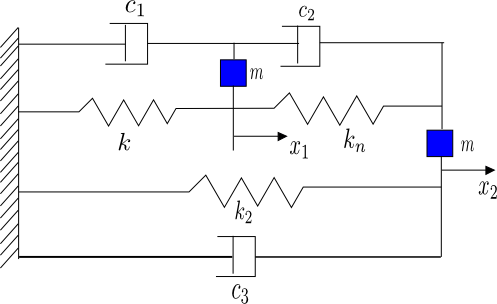Let us consider the discrete system, reference [1]

figure png file
Kinetic energy:
|

|
(1)
|
Potential energy:
|

|
(2)
|
The dissipation energy:
|

|
(3)
|
and then write the equations of motion using Lagrange's equations:
|

|
(4)
|
where generalzied forces:
|

|
(5)
|
Substitute (1),(2),(3) and (5) to (4) to get:
|
![{\displaystyle \displaystyle m{\ddot {x}}_{1}+\left[kx_{1}-k_{n}(x_{2}-x_{1})\right]=-c_{1}{\dot {x}}_{1}+c_{2}({\dot {x}}_{2}-{\dot {x}}_{1})}](https://wikimedia.org/api/rest_v1/media/math/render/svg/6339e92dfe9e79d9a8d9c9c5b15fab20f945c596)
|
(6)
|
|
![{\displaystyle \displaystyle m{\ddot {x}}_{2}+\left[k_{2}x_{2}+k_{n}(x_{2}-x_{1})\right]=-c_{2}({\dot {x}}_{2}-{\dot {x}}_{1})-c_{3}{\dot {x}}_{2}}](https://wikimedia.org/api/rest_v1/media/math/render/svg/70a43dab9df536fa0366a1f71d101921b3b12266)
|
(7)
|
or
|

|
(8)
|
|

|
(9)
|
Assume the solutions of (8) and (9) having the following normal modes:
|

|
(10)
|
Plugging (10) to (8) and (9):
|
![{\displaystyle \displaystyle [k_{n}+k+(c_{1}+c_{2})\omega +m\omega ^{2}]A_{1}-(k_{n}+\omega c_{2})A_{2}=0}](https://wikimedia.org/api/rest_v1/media/math/render/svg/312ac6b7990ca57971ed69f3dfb683a4904cb3f9)
|
(11)
|
|
![{\displaystyle \displaystyle -(k_{n}+\omega c_{2})A_{1}+[k_{n}+k_{2}+(c_{2}+c_{3})\omega +m\omega ^{2}]A_{2}=0}](https://wikimedia.org/api/rest_v1/media/math/render/svg/17a7e33a11bf4db719fcafa75390f802e079c49f)
|
(12)
|
(11) and (12) have non-trial solutions if the determinant of the coefficients of  is zero:
is zero:
|
![{\displaystyle \displaystyle [k_{n}+k+(c_{1}+c_{2})\omega +m\omega ^{2}][k_{n}+k_{2}+(c_{2}+c_{3})\omega +m\omega ^{2}]-(k_{n}+\omega c_{2})^{2}=0}](https://wikimedia.org/api/rest_v1/media/math/render/svg/5ddea1e6ec3d343d6a7ec96930c4fdb4902a6eec)
|
(13)
|
or rewrite this in the form of unknown 
|
![{\displaystyle \displaystyle m^{2}\omega ^{4}+(c_{1}+2c_{2}+c_{3})m\omega ^{3}+[c_{1}c_{2}+c_{2}c_{3}+c_{3}c_{1}+(k+k_{2}+2k_{n})m]\omega ^{2}+[c_{1}(k_{2}+k_{n})+c_{2}(k+k_{2})+c_{3}(k+k_{n})]\omega +kk_{2}+(k+k_{2})k_{n}=0}](https://wikimedia.org/api/rest_v1/media/math/render/svg/0d1587f326c6b9f78a3795c6cf2dc9fcc275561e)
|
(14)
|
(8) and (9) have bounded solutions as time goes to infinity if  . We will use this condition to impose conditions on the coefficients of equation (14). Before doing this, let us review a famous Hurwitz's theorem, reference, [2]
. We will use this condition to impose conditions on the coefficients of equation (14). Before doing this, let us review a famous Hurwitz's theorem, reference, [2]
An equation of order n
|

|
(15)
|
has all solutions (complex or real) with negative parts if the following conditions are satisfied:
|

|
(16)
|
Apply this condition for the 4th order equation:
|

|
(17)
|
we obtain:
|

|
(18)
|
It is easy to prove that (18) is equivalent to the following condition:
|

|
(19)
|
Now require (19) must be true for coefficients of equation (14)
|

|
(20)
|
and
|
![{\displaystyle \displaystyle {\begin{Bmatrix}[c_{1}(k_{2}+k_{n})+c_{2}(k+k_{2})+c_{3}(k+k_{n})]{\begin{pmatrix}m(c_{1}+2c_{2}+c_{3})[c_{1}c_{2}+c_{2}c_{3}+c_{3}c_{1}+(k+k_{2}+2k_{n})m]\\-m^{2}[c_{1}(k_{2}+k_{n})+c_{2}(k+k_{2})+c_{3}(k+k_{n})]\end{pmatrix}}\\-m^{2}(c_{1}+2c_{2}+c_{3})^{2}(kk_{2}+(k+k_{2})k_{n})\end{Bmatrix}}>0}](https://wikimedia.org/api/rest_v1/media/math/render/svg/362521298d61810d3803628b4d026a70c91a75d3)
|
(21)
|
First we assume all dampers are positive and springs  have positive stiffnesses while spring
have positive stiffnesses while spring  can have negative stiffness.
can have negative stiffness.
|

|
(22)
|
With these conditions, the first inequality of (20) is satisfied. Now we will prove that if the third of (20) is also satisfied:
|

|
(23)
|
then the second condtion of (20) and condition (21) automatically satisfied.
Indeed, (23) infers:
|

|
(24)
|
Now, determine
|
![{\displaystyle \displaystyle {\begin{aligned}a_{1}a_{2}-a_{0}a_{3}&=m(c_{1}+2c_{2}+c_{3})[c_{1}c_{2}+c_{2}c_{3}+c_{3}c_{1}+(k+k_{2}+2k_{n})m]-m^{2}[c_{1}(k_{2}+k_{n})+c_{2}(k+k_{2})+c_{3}(k+k_{n})]\\&=m(c_{1}+2c_{2}+c_{3})[c_{1}c_{2}+c_{2}c_{3}+c_{3}c_{1}]+m^{2}[(c_{1}+2c_{2}+c_{3})(k+k_{2}+2k_{n})-c_{1}(k_{2}+k_{n})-c_{2}(k+k_{2})-c_{3}(k+k_{n})]\\&=m(c_{1}+2c_{2}+c_{3})[c_{1}c_{2}+c_{2}c_{3}+c_{3}c_{1}]+m^{2}[(c_{1}(k+k_{n})+c_{2}(k+k_{2}+4k_{n})+c_{3}(k_{2}+k_{n}))\\\end{aligned}}}](https://wikimedia.org/api/rest_v1/media/math/render/svg/230b7d8df21119028d02bd1bbe010dfe44152805)
|
(25)
|
to see that:
|
![{\displaystyle \displaystyle {\begin{aligned}a_{3}(a_{1}a_{2}-a_{0}a_{3})-a_{1}^{2}a_{4}&=a_{3}m(c_{1}+2c_{2}+c_{3})[c_{1}c_{2}+c_{2}c_{3}+c_{3}c_{1}]+m^{2}\underbrace {\begin{Bmatrix}a_{3}[c_{1}(k+k_{n})+c_{2}(k+k_{2}+4k_{n})+c_{3}(k_{2}+k_{n})]\\-(c_{1}+2c_{2}+c_{3})^{2}[kk_{2}+(k+k_{2})k_{n}]\end{Bmatrix}} _{\mathbf {P} }\end{aligned}}}](https://wikimedia.org/api/rest_v1/media/math/render/svg/e2154585a2701358492b0533072dd5d1011a7b4b)
|
(26)
|
The first term (26) is obviously positive, the second term is:
|

|
(27)
|
After some operations to rewrite (27) in the following form, which is also positive:
|

|
(28)
|
Finally we conlcude that for the discrete system above stable, the conditions are (22) and (23). These conditions also reveal that adding positive dampers does not change the stability requirements of the system.






![{\displaystyle \displaystyle m{\ddot {x}}_{1}+\left[kx_{1}-k_{n}(x_{2}-x_{1})\right]=-c_{1}{\dot {x}}_{1}+c_{2}({\dot {x}}_{2}-{\dot {x}}_{1})}](https://wikimedia.org/api/rest_v1/media/math/render/svg/6339e92dfe9e79d9a8d9c9c5b15fab20f945c596)
![{\displaystyle \displaystyle m{\ddot {x}}_{2}+\left[k_{2}x_{2}+k_{n}(x_{2}-x_{1})\right]=-c_{2}({\dot {x}}_{2}-{\dot {x}}_{1})-c_{3}{\dot {x}}_{2}}](https://wikimedia.org/api/rest_v1/media/math/render/svg/70a43dab9df536fa0366a1f71d101921b3b12266)



![{\displaystyle \displaystyle [k_{n}+k+(c_{1}+c_{2})\omega +m\omega ^{2}]A_{1}-(k_{n}+\omega c_{2})A_{2}=0}](https://wikimedia.org/api/rest_v1/media/math/render/svg/312ac6b7990ca57971ed69f3dfb683a4904cb3f9)
![{\displaystyle \displaystyle -(k_{n}+\omega c_{2})A_{1}+[k_{n}+k_{2}+(c_{2}+c_{3})\omega +m\omega ^{2}]A_{2}=0}](https://wikimedia.org/api/rest_v1/media/math/render/svg/17a7e33a11bf4db719fcafa75390f802e079c49f)

![{\displaystyle \displaystyle [k_{n}+k+(c_{1}+c_{2})\omega +m\omega ^{2}][k_{n}+k_{2}+(c_{2}+c_{3})\omega +m\omega ^{2}]-(k_{n}+\omega c_{2})^{2}=0}](https://wikimedia.org/api/rest_v1/media/math/render/svg/5ddea1e6ec3d343d6a7ec96930c4fdb4902a6eec)

![{\displaystyle \displaystyle m^{2}\omega ^{4}+(c_{1}+2c_{2}+c_{3})m\omega ^{3}+[c_{1}c_{2}+c_{2}c_{3}+c_{3}c_{1}+(k+k_{2}+2k_{n})m]\omega ^{2}+[c_{1}(k_{2}+k_{n})+c_{2}(k+k_{2})+c_{3}(k+k_{n})]\omega +kk_{2}+(k+k_{2})k_{n}=0}](https://wikimedia.org/api/rest_v1/media/math/render/svg/0d1587f326c6b9f78a3795c6cf2dc9fcc275561e)







![{\displaystyle \displaystyle {\begin{Bmatrix}[c_{1}(k_{2}+k_{n})+c_{2}(k+k_{2})+c_{3}(k+k_{n})]{\begin{pmatrix}m(c_{1}+2c_{2}+c_{3})[c_{1}c_{2}+c_{2}c_{3}+c_{3}c_{1}+(k+k_{2}+2k_{n})m]\\-m^{2}[c_{1}(k_{2}+k_{n})+c_{2}(k+k_{2})+c_{3}(k+k_{n})]\end{pmatrix}}\\-m^{2}(c_{1}+2c_{2}+c_{3})^{2}(kk_{2}+(k+k_{2})k_{n})\end{Bmatrix}}>0}](https://wikimedia.org/api/rest_v1/media/math/render/svg/362521298d61810d3803628b4d026a70c91a75d3)





![{\displaystyle \displaystyle {\begin{aligned}a_{1}a_{2}-a_{0}a_{3}&=m(c_{1}+2c_{2}+c_{3})[c_{1}c_{2}+c_{2}c_{3}+c_{3}c_{1}+(k+k_{2}+2k_{n})m]-m^{2}[c_{1}(k_{2}+k_{n})+c_{2}(k+k_{2})+c_{3}(k+k_{n})]\\&=m(c_{1}+2c_{2}+c_{3})[c_{1}c_{2}+c_{2}c_{3}+c_{3}c_{1}]+m^{2}[(c_{1}+2c_{2}+c_{3})(k+k_{2}+2k_{n})-c_{1}(k_{2}+k_{n})-c_{2}(k+k_{2})-c_{3}(k+k_{n})]\\&=m(c_{1}+2c_{2}+c_{3})[c_{1}c_{2}+c_{2}c_{3}+c_{3}c_{1}]+m^{2}[(c_{1}(k+k_{n})+c_{2}(k+k_{2}+4k_{n})+c_{3}(k_{2}+k_{n}))\\\end{aligned}}}](https://wikimedia.org/api/rest_v1/media/math/render/svg/230b7d8df21119028d02bd1bbe010dfe44152805)
![{\displaystyle \displaystyle {\begin{aligned}a_{3}(a_{1}a_{2}-a_{0}a_{3})-a_{1}^{2}a_{4}&=a_{3}m(c_{1}+2c_{2}+c_{3})[c_{1}c_{2}+c_{2}c_{3}+c_{3}c_{1}]+m^{2}\underbrace {\begin{Bmatrix}a_{3}[c_{1}(k+k_{n})+c_{2}(k+k_{2}+4k_{n})+c_{3}(k_{2}+k_{n})]\\-(c_{1}+2c_{2}+c_{3})^{2}[kk_{2}+(k+k_{2})k_{n}]\end{Bmatrix}} _{\mathbf {P} }\end{aligned}}}](https://wikimedia.org/api/rest_v1/media/math/render/svg/e2154585a2701358492b0533072dd5d1011a7b4b)

